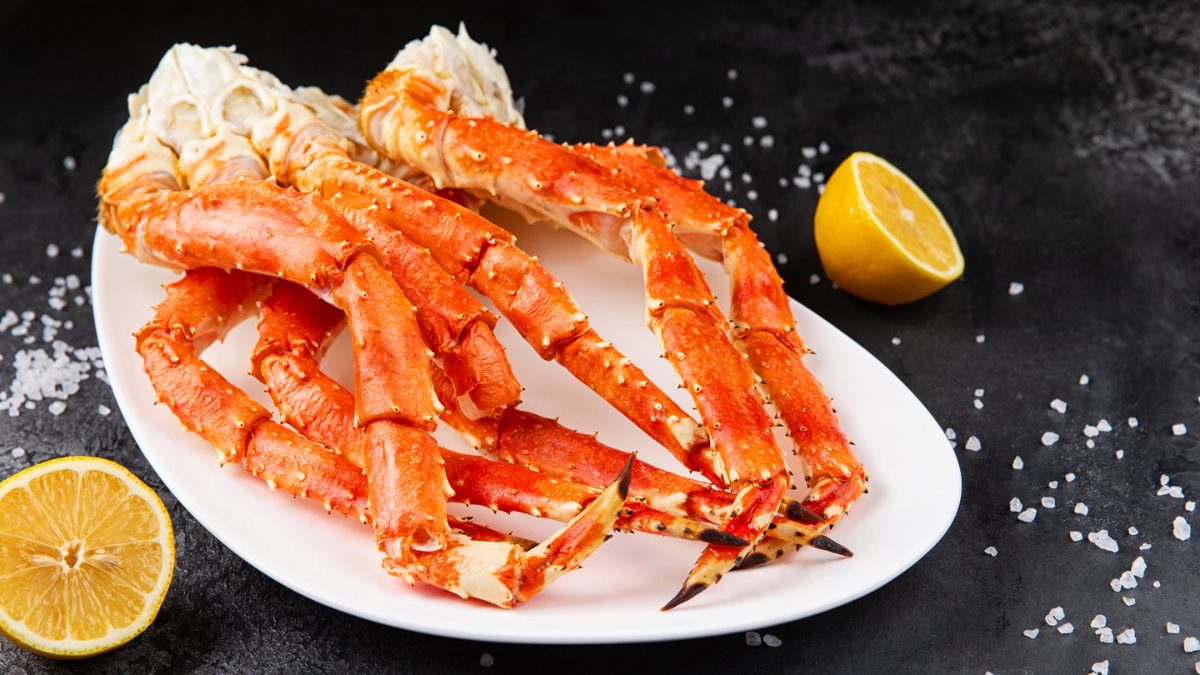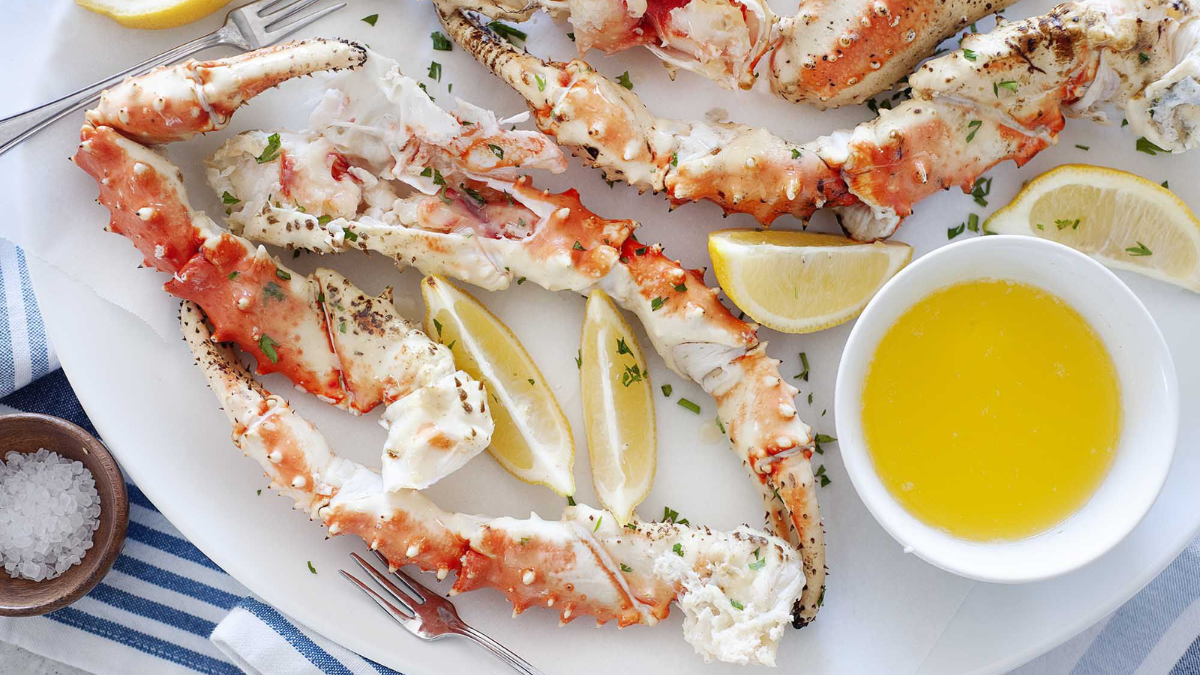One of the simplest meals to prepare at home is crab legs. Enjoy this gourmet delicacy at home instead of paying the high restaurant markups. We’ll demonstrate how to cook crab legs. There’s virtually no way to make preparing crab legs at home any simpler. Crab legs can be cooked to perfection even by the most inexperienced cooks. Crab legs can be prepared in three ways: boiling, steaming, and broiling in the oven.
Crab legs are a common representation of upscale cuisine. When you see crab legs at a reception, you know you’re in for a great feast and that there will likely be other opulent treats. To enjoy this succulent delight, you do not need to wait to go out to dine or to be invited to a special event. Home cooking crab legs is much simpler than you might think.
Crab
If you enjoy eating crab as much as we do, the thought of all the delectable dinners you could prepare with that many crabs may make you hungry. However, only a select few crab species possess the ideal mix of qualities to make it onto our menus.
There are countless ways to consume crab meat, from chowders and deep-fried snacks to crab cakes and seafood boil. You can even think of crab as a health-conscious food because it contains protein, vitamins, and minerals.
It shouldn’t come as a surprise that not all crabs are edible, given that there are thousands of different crab species. Others are truly quite hazardous to humans, while others don’t contain enough meat to be worth the hassle.
Therefore, no, you cannot eat any crab you come across. Fortunately, the entire can select all kinds of crabs; we can provide a wide range of flavor profiles and cooking possibilities. Let’s explore some of the most devoured crab breeds on the East Coast, West Coast, and everywhere.
Crab Legs
There are many edible crab species worldwide, but just a few are typically taken for their legs. Compared to choosing a type of fish or even a cut of beef, finding the best crab legs to cook at home is a much simpler chore. The most common varieties of crab legs you can purchase at fish markets and supermarkets are listed below.
King Crab
One of the most popular varieties of crab legs on the market, king crab legs are frequently a popular item at seafood buffets. Interestingly, they are a near relative that evolved the characteristics of the crab for its survival, not a true crab at all.
They are appreciated for their extraordinarily long legs, which account for a large portion of their immense size (some are as wide as five feet!). Their meat is strong and keeps together when you take it from the shell, almost like lobster, but they are more expensive. Additionally, some equipment is needed to crack open their thick shells. However, many fishmongers will split the shells so diners can enjoy their meals without needing additional equipment.
Snow Crab
Stone Crab
How to Prepare Pre-Cooked Crab Legs?
These sea critters’ delicious, juicy meat can arguably be best enjoyed with a straightforward preparation that doesn’t interfere or compete with the crab’s natural characteristics. Crab legs are often eaten hot or cold.
Cold Crab Legs
Although it’s the most common way to consume stone crabs, you can eat all crab legs cold. All you have to do to prepare them for eating is defrost them. Your frozen crab legs should be placed in a colander over a dish and left on the bottom shelf of your refrigerator overnight to defrost.
You can have delectable crab legs for breakfast in the morning if you wish. Lay the crab legs in a colander and set it in the sink under cool running water for around 15 minutes or until the legs are defrosted if you just bought some crab legs and want to eat them right away.
Hot Crab Legs
The simplest way to heat them if you want to enjoy them is to boil them. If you’re starting with frozen crab legs, just put them in a big pot, bend, and tuck them in until they all fit. Bring to a boil and then cover with chilled water. The crabs should be thoroughly boiled once the water reaches boiling.
How to Cook Crab Legs?
Ingredients
- 8 quarts water
- 1/4 cup salt
- 2 pounds fresh or frozen cooked snow crab legs, thawed
- Melted butter and lemon wedges
Tools
- A large stockpot
- Long-handled tongs
- Kitchen shears, a seafood cracker or mallet, or a nutcracker
- A steamer basket (optional)
Method 1 Boiling
One of the best methods to prepare crab legs is to boil them. The water keeps everything juicy and wet by sandwiching it between the cooked meat and the shell. All you need to do is heat the crab legs fully cooked when frozen.
Boil the Water
The most crucial step in this procedure is to get a stockpot big enough to hold your crab legs. About 2 pounds of crab legs can fit comfortably in most big stockpots or Dutch ovens without spilling. Once you’ve located your pot, add the salt and fill it with cold tap water. Bring the water to a boil in the pot by setting it over high heat.
Add the Crab Legs
Before lowering the heat to a simmer, bring the water back to a boil. Using long-handled tongs, slowly lower the crab legs into the boiling water. To ensure that the hot water completely covers the crabs, bend them at the joints and tuck them within.
The crab legs should only need to simmer for 5 minutes to reach the desired temperature. When fully heated, use your tongs to remove the legs and lay them aside to cool a little before handling.
Method 2 Steaming
Boiling crab legs and steaming them is pretty similar. Some claim that steaming is preferable to cooking because it prevents the flavor of the crab from escaping into the cooking liquid. If you wish to boil the entire 2 pounds of crab legs in this recipe, remember that most steamer baskets can only contain about 1 pound of crab.
Prepare the Water
Make sure you have a stockpot big enough to fit your crab legs, much like when you boil crab legs. Over 1 inch of water, place the steamer basket. Once the water is boiling, put the crabs in the steamer basket.
Steam for 5-7 Minutes
Reduce the heat to a simmer once the water has boiled, then cover the stockpot. Keep the crab legs simmering for 5-7 minutes, or until they are thoroughly heated. Take the legs from the warm crab with long-handled tongs and place them aside to cool briefly.
Method 3 Broiling Crab Legs
When reheating crab legs, broiling them in the oven is a fantastic method to add some delicious buttery taste. With this technique, the crab legs will also somewhat caramelize due to the broiler’s high heat, offering an additional layer of taste. Only around 1 pound of crab legs can often be cooked at once on a sheet pan.
Preheat the Oven
Activate the “high” broiler setting on the oven. Line a 15x10x1-inch baking pan with aluminum foil or parchment paper to prepare it.
Broil the Crab Legs
Place the crab legs on the baking sheet that has been prepared and brush them with one tablespoon of melted butter or olive oil. The crab legs should be baked on each side for 3 to 4 minutes with the sheet pan 5 to 6 inches from the broiler.
Serve and Enjoy
The most typical way to serve crab legs is with melted butter and lemon wedges on the side. You can pour lemon juice over the meat once it has been taken out of the shells and then dip it in melted butter.
Serving crab flesh with Old Bay seasoning, a blend of herbs and spices that goes well with seafood, is another preferred serving option in the New England region—onto a platter, sprinkling some of the spice. Before eating, drizzle some lemon juice over some butter and sprinkle some Old Bay seasoning on top.
How to Buy Crab Legs?
Since there aren’t many options for the sort of crab, picking the greatest crab legs is fairly simple. Availability varies considerably by location, so grab what you can! However, in case you do have options, here is a summary of the most popular varieties of crab to aid in your decision:
- King crab – The largest crab legs are king crabs with spiky, thick shells. King crabs typically cost more since they have a few-week-long, relatively limited harvesting season. The greatest crab legs are made with king crab, the cream of the crop! Crab meat’s buttery texture and sweet, succulent flavor are reminiscent of lobster meat.
- Snow crab – The Northern seas are home to snow crabs with smaller, longer legs. I typically get snow crabs since the clusters of crab legs are still a nice size and less expensive than king crab. They cook to a snowy white hue, a firm texture, and a flavor that is both sweet and salty.
- Stone crab – These tiny crabs, also referred to as Florida stone crabs, are brownish-red and have broad claws with black tips. Stone crab is frequently compared to a combination of shrimp and lobster in terms of flavor. Due to their tiny and petite legs, they are better suited to creating crab claws or serving chilled, like shrimp cocktails.
Conclusion
Crabs come in numerous varieties that compare them to other animals and can be likened to turkeys to quail. Crabs come in a wide variety, and they are consumed worldwide. As a result, claiming you enjoy eating crab is similar to saying you enjoy eating birds.
On the streets of Vietnam, you can buy small, fried, soft-shelled crabs that are about the size of your palm. On the end of the range are coconut crabs the size of a person and enormous, carnivorous spider crabs. Although Japanese spider crabs have legs extending up to 13 feet, coconut crabs are the largest arthropods.


